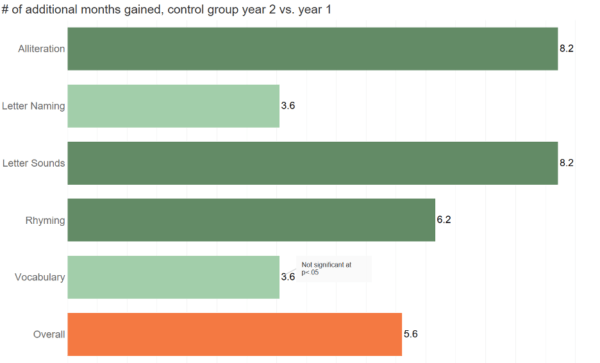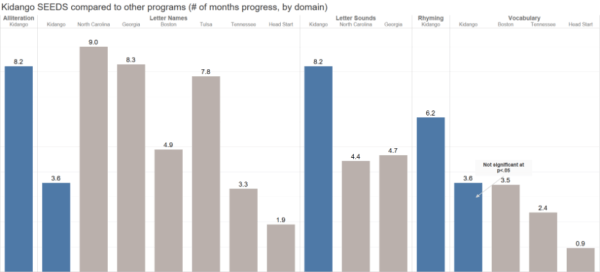Kidango is committed to evaluating the impacts of our programs to ensure a high-quality service that fully prepares children for Kindergarten. We work internally as well as with external partners to analyze the effects of our programs, enabling a process of continuous quality improvement.
NORC Results
The results for Year 2 show dramatic growth and statistically significant impacts in children’s language and literacy skills. The assessment tool that was used is called the Individual Growth and Development Indicators (IGDIs). Developed by the University of Minnesota, the IGDIs are based on scientific research and measure critical language and literacy skills that are important for language proficiency in the 3rd grade and later. The IGDIs were designed to help teachers, parents and others with valid, reliable data on children’s growth and development.
Specifically, the IGDIs focus on a set of 5 early reading measures:
- Vocabulary (Picture Naming / Oral Language)
- Rhyming (Phonological Awareness)
- Sound Identification (Letter Sounds / Alphabet Knowledge)
- Letter Naming (Reading)
- Alliteration (Phonological Awareness)
NORC’s study reveals how children in Kidango’s SEEDS program acquired the equivalent of up to 8 months of additional learning gains:

As the figure shows, the overall impact of the SEEDs program is equivalent to almost 6 months of additional learning.
Kidango compares favorably with several acclaimed programs. We can use the effects of those programs, as calculated by scientific studies, to compare the additional learning gains of children across similar skills:

Sources:
| Boston: Weiland, Christina, and Hirokazu Yoshikawa. 2013. “Impacts of a Prekindergarten Program on Children’s Mathematics, Language, Literacy, Executive Function, and Emotional Skills.” Child Development 84 (6): 2112–30. |
| Georgia: Peisner-Feinberg, Ellen S., Jennifer M. Schaaf, Doré R. LaForett, Lisa M. Hildebrandt, and John Sideris. 2014. “Effects of Georgia’s Pre‐K Program on Children’s School Readiness Skills: Findings from the 2012–2013 Evaluation Study.” Chapel Hill: University of North Carolina, Frank North Carolina: Porter Graham Child Development Institute. http://fpg.unc.edu/sites/fpg.unc.edu/files/resources/reports-and-policy-briefs/GAPreKEval_RDDReport%203-4-2014.pdf. |
| Head Start: Puma, M., Bell, S., Cook, R., Heid, C., & Lopez, M. (2005). Head Start impact study: First year findings. Administration for Children & Families. |
| North Carolina: Peisner-Feinberg, Ellen S., and Jennifer M. Schaaf. 2011. “Summary of Key Findings Effects of the North Carolina More at Four Pre-Kindergarten Program on Children’s School Readiness Skills.” Chapel Hill: University of North Carolina, Frank Porter Graham Child Development Institute. http://fpg.unc.edu/sites/fpg.unc.edu/files/resources/reports-and-policy-briefs/MAF_Yr9_key_findings.pdf. |
| Tennessee: Lipsey, M. W., Farran, D. C., Bilbrey, C., Hofer, K. G., & Dong, N. (2011). Initial results of the evaluation of the Tennessee Voluntary Pre-K Program. Nashville, TN: Peabody Research Institute, Vanderbilt University. |
| Tulsa: Gormley, William T., Deborah Phillips, and Ted Gayer. 2008. “Preschool Programs Can Boost School Readiness.” CROCUS Working Paper No. 12. Washington, DC: Georgetown University. https://georgetown.app.box.com/s/fpq610v9n7iaqifvmquf. |





